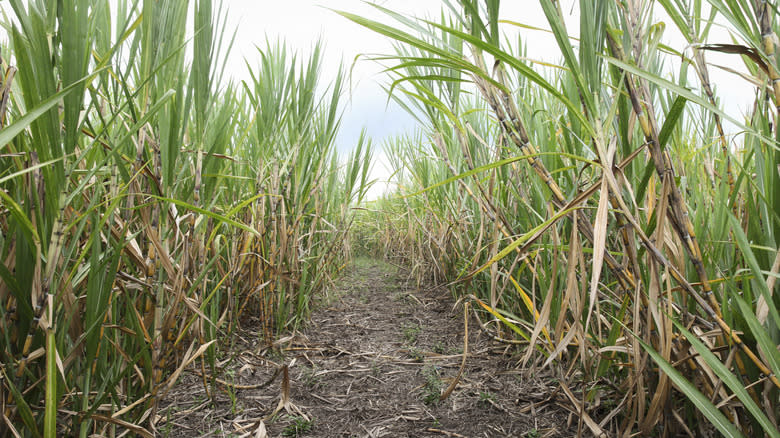The USDA Expects The Sugar Supply To Take A Hit Due To Severe Drought

From olive oil in Italy to beef in Texas, severe drought has hit the global food supply with a connecting uppercut over the past year. (Surprise: There's more.) The USDA released its World Agricultural Supply and Demand Estimates (WASDE) report on October 12, and things aren't looking great for sweet-toothed foodies.
The USDA forecasts the total U.S. sugar supply to clock in around 14,222,000 tons, down 419,000 tons from 2022-23 (via Food Business News). Even though America is one of the top sugar-producing countries in the world, U.S. the yield for 2023-2024 is predicted to be 2.9% less than last year. Louisiana (the largest cane sugar growing region in America) was hit with a nasty drought this year. Although some of the crop was rescued by a period of sudden rainfall late in the summer growing season, the drought stunted what are normally 7-foot-tall plants down to 5 feet. Eddie Lewis of Eddie Lewis Sugarcane Farms LLC estimates that 20-30% of the state's sugarcane crop will be unusable this year, via local news outlet KATC.
It wasn't just Louisiana, either. Six of the top 10 sugar-producing countries in the world have been plagued with extreme weather this year. Drought raged in Mexico and Pakistan, and flooding spread across the U.S., Europe, China, and India. Sugar output fell nearly 25% in Thailand, and experts anticipate a 10-15% decrease in the total global sugar supply for the upcoming market year.
Read more: Styles Of Regional BBQ In The US
Foodies Worldwide, Prepare To Go Savory

With the first-of-its-kind severity of this drought comes unpredictable ramifications. Still, Louisiana sugarcane specialist Kenneth Gravois says this drop won't drastically change farmers' or consumers' day-to-day reality. "Some states are going to have good years, some states are going to be affected by the weather and have a little bit lower production but across the whole for the U.S. we'll have sugar on the shelves," Gravois tells local news outlet WAFB.
Likely, the shortage is going to be most palpable in the grocery store. Sugar prices have skyrocketed already, increasing by 42% over 2022-2023. That marks a 12-year high tied to the disruption caused when El Niño hit Brazil in 2009. Now, Halloween candy prices may leap as the sugar supply dwindles around the world. Extreme drought is also affecting 2024 flour prices. It's not just about grocery stores, either. Sugar is used in foods, beverages, medicines, building materials, livestock feeds, cosmetics, bioplastics, detergents, and ethanol fuel.
To offset the deficit, some American manufacturers have been turning to foreign sugar imports, which went up by 8.6% to 3,277,000 tons, per the WASDE report. Although, a number of confounding variables remain at play. The U.S. is Mexico's largest foreign buyer of sugar exports, but the USDA only allows a certain amount of sugar to be imported under trade permits. Perhaps redemptively, it remains unclear exactly how much inventory Mexican sugar mills currently have in storage; experts speculate that it could potentially be enough to meet market demands.
Read the original article on Tasting Table.
